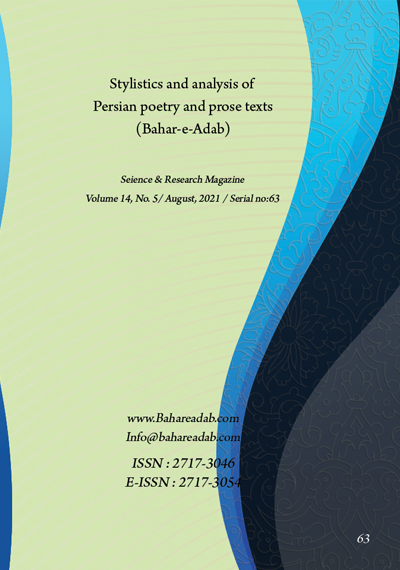- Count View : 458
- آدرس کوتاه شده مقاله: https://bahareadab.com/article_id/1124
- کد doi مقاله: Doi: 10.22034/bahareadab.2021 .14 .5508
Journal of the stylistic of Persian poem and prose
volume Number 14،
number In Volume 5،
،
issue Number 63
The Study and Analysis of Characters’ Dialogues in Samak-E Ayyār
Tahereh Hassani , Mohammad Ali Davoodabadi Farahani (Author in Charge), Mohammad Reza Qari
Abstract
BACKGROUND AND OBJECTIVES: Samak-E-Ayyār is one of the most famous Persian folktale which has flourished in 6th century and it is known as romance. dialogue is one of the critical elements of fiction which has got the effective role in identifying the characters. Study and analysis of dialogue element are the main topic of this research. In this paper the researcher tries to analyze the dialogue function and role in Samak-E-Ayyār.
METHODOLOGY: The present research is organized based on library resources and descriptive- analytical method. basically, this paper has studied Samak-E-Ayyār corrected by Parviz Natel Khanlari and published by Agah Press.
FINDINGS: Following narration in Samak-E-Ayyār, there are direct and indirect dialogues. Most dialogues are short and reflex the pure classic prose of sixth century. In this work characters haven’t got distinct representation.
CONCLUSION: The function and role of dialogue in Samak-E-Ayyār have been demonstrated as argument, discussion and conflict. To reason the discourse, the mild language and errant’ reasoning, ministers and scholars are realized. Some facts, judgments and views are narrated by characters as well as narrator and it leads to democratic discourse. Love, suppliant and prayer are the reasons of emotional and sentient dialogue, characters’ performances make the audiences know them and bring along identification with the heroes. Dialogues are going to show as followings: They reflex events and adventures which help the narrative progress. Happy and sad settings are created by dreaming and astrology. Descriptions in dialogue deal to further introduction or recognition. Story’s climax and anticlimax, complication and denouement are appeared superiorly. Besides dialogues help the time acceleration of in Samak-E-Ayyār.
Keyword
romance
, Samak-E-Ayyār
, elements of fiction
, dialogue
, character
- Arrajānī, F. kh. A. (1983). Samak-E Ayyar. Corr. Dr. Parviz Natel Khanlari. 5 vols. Tehran: Agah.
- Scholes, R. (2016). Elements of Fiction. Trans. Farzaneh Taheri. Tehran: Markaz, p.10.
- Allott, M. (2009). Novelists on the Novel. Trans. Mohammad Ali Haghshenas. Tehran: Markaz, p.514.
- Bakhtin, M.M. (1981). The Dialogic Imagination( studies about romance). Trans. Roya Pour Azar. Tehran: Ney.
- Beer, G. (2000). The romance. trans. Sudabeh Daghighi. Tehran: Markaz, p.73.
- Parsi Nejad,K. (1999). Structure and elements of fiction. Tehran: Sure, pp.100-101.
- Todorov, T. (2000). structuralize poetics. Trans. Mohammad Nabavi. Tehran: Agah, p.478.
- Tavakoli, H.R. (2012). From Hints of the Sea (Poetics of narrative in Masnavi). Tehran: Morvarid, p.487.
- Jalali Pandari, Y. and Hoseini, R. (2012). Stratagems and schemes in Samak-E Ayyar. Literary Studies, 3(2), pp.103-132.
- Hesampour, S. (2017). Survey and comparison of storytelling in Samak E Ayyar with three folk tales.
- Culture and Folk Literature, 5(12), pp.111-138.
- Khaefi, A. and Feyzi ganjin, J. (2007). The analysis of Samak-E Ayyar’s Tale Based on Vladimir Propp's Theory.
- Literary Research,5(18), pp.33-51
- . Soleimani, M. (2000). The art of storytelling. Tehran: AmirKabir, p.365.
- Abbasi, S. (2016). Poetic of long story. Tehran: Roozgar. Morgan Foster. E. (1990). Aspects of the Novel . Trans.
- Ebrahim Younesi. Tehran: Negah, p.116.
- Mirsadeghi, J. (2011). Fiction. 3rd.ed. Tehran: Sokhan, p.295.
- Mirsadeghi, J. (2013). Elements of fiction. 3rd.ed. Tehran: pp: 84-463.
- Mirsadeghi, J. and Mirsadghi, M. (2015). The fiction dictionary. 3rd ed. Tehran: Mahnaz, p.11.

